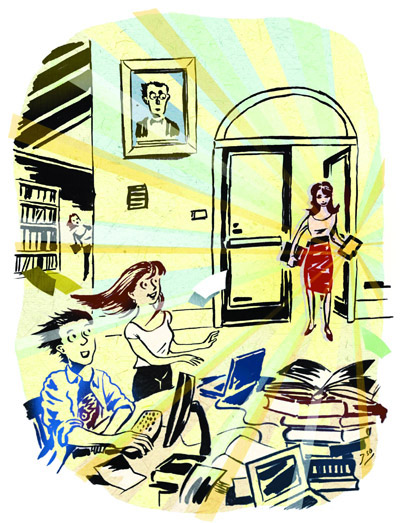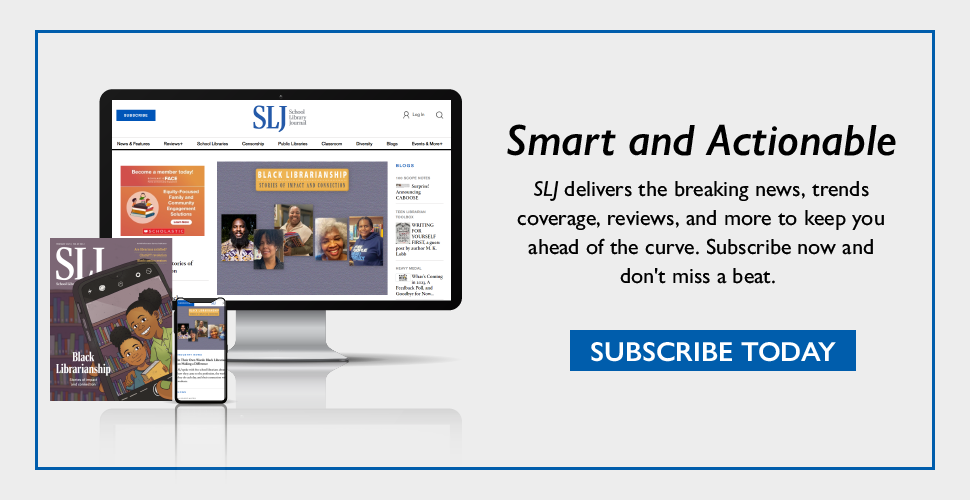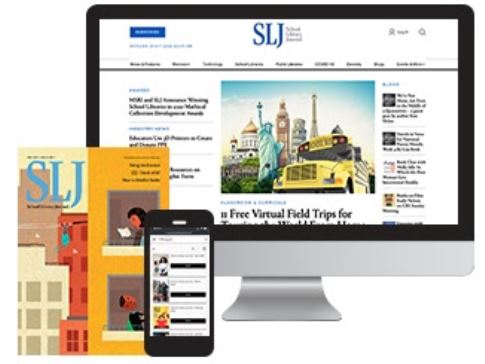Fully Loaded: Outfitting a teacher librarian for the 21st century. Here's what it takes.

Illustration by John S. Dykes
What does it mean to be fully loaded?
I often consider the notion for my students. In fact, ever since I acquired the first apps for my iPhone, I’ve adopted the admittedly odd habit of pondering which apps I would “load” onto my students.
If, indeed, high school students were smartphones or iPads, I would do my very best to fully load them with the critical skills and tools they need to become information- and media-fluent adults. But teenagers aren’t my only learners.
Like many of you, I’m often blessed with the opportunity to mentor preservice teacher librarians. Many visit our school and shadow me. And two local universities with school library programs regularly send me practicum students. This semester, we’re especially pleased to have Nora Neumann join us at Springfield Township High School.
A former nurse who also volunteered with us as a parent, Nora is nearing the completion of her Masters of Education program at Arcadia University in Philadelphia and will soon receive her teacher-librarian credential. Our students know “Mrs. Neumann” from the neighborhood and she’s become part of our library family. Like all my other student teachers, Nora arrived with her official practicum checklist in hand, the standard university accounting of the experiences she should have and the proficiencies she should develop during her time at Springfield. It’s a good checklist, one designed to ensure that we’ll work together to hone the general skills she’ll need to become a successful teacher, as well as the perspective and philosophical mind-set required to be an effective teacher librarian.
But there are gaps, missing competencies critical for contemporary practice. So I have an addendum to Nora’s list, apps I’d like to load onto every student teacher-librarian’s “screen,” if he or she is to have true credibility in leading a school through an information and communication landscape that’s continually in flux. For starters, any teacher librarian worth his or her salt in 2011 must be on top of the latest strategies and tools for searching, not to mention organizing information and telling digital stories.
I’d like future teacher librarians to leave their practicum mentors with a few fairly granular competencies—for instance, how best to present the elements of your program online—ones that don’t appear on your typical preservice checklist, but will prepare them for their real-life work with students and faculty. Competencies that will encourage them to continue to develop new skills.
With the understanding that this list will need revisiting every couple of years, here are my nonnegotiable requirements for 2011:
Mastery of a couple of publishing platforms for creating a library web presence. This could mean wikis, blogs, Google Sites, LibGuides (a hosted service for creating research guides), or Netvibes (to create personal start pages). Having a strong library web presence is no longer optional. It represents us as information professionals and allows us to interact with our learning communities 24/7. See SchoolLibraryWebsites for examples of various applications that librarians have put into practice. You should also be able to integrate, teach, and share these platforms with your learning community when they make curricular sense.
Mastery of the tools needed to create web-based pathfinders for student and faculty research and production. (This will likely include the tools listed above and perhaps a few others like Only2Clicks, a free service that organizes your bookmarks by tabs, or online organizer LiveBinders. (See Pathfinder Swap for some examples and please add your own.)
Mastery of three or four of the wonderful applications for telling digital stories and communicating research results. My top picks would be VoiceThread, Animoto, Glogster, xtranormal, GoAnimate, and ToonDoo. Find more digital storytelling applications on this pathfinder.
Mastery of three or four of the cool tools for publishing digital work. By that I mean your library updates and reports as well as student work and curricular materials. Those brilliant student papers, essays, and poems should be published, celebrated, and archived—not trashed when the unit’s over. Your students’ best work should have an audience. Find related tools here.
Understanding of intellectual property. Get your mind around both Creative Commons (an alternative to traditional copyright, which allows creators to grant additional rights to users of their content) as well as the concept of fair use. Do your very best to say “yes” in allowing responsible and respectful remixing of media.
Understanding of new search tools and strategies. These competencies include the ability to creatively use and exploit Google’s full capacities and help learners build appropriate search tool kits that include databases, search engines, portals, directories, RSS feeds, and readers. You’ll be able to lead learners and teachers in creating their own personal information portals.
Ability to create a Google Custom Search, your own federated search, across the tools that are most useful or appropriate for your learners.
Ability to create, share, and teach using the latest writing tools, including, mindmapping, outlining, and storyboarding applications, as well as tools for composing, such as Google Docs and its lovely shared templates.
Ability to conduct original research using interactive polling tools like Google Forms and PollEverywhere.
Ability to embed widgets and to teach others how. This very simple and perhaps the most granular skill allows professionals and learners to piece together major websites, create anthologies, and portfolios of student work, and weave together lessons that include multiple media.
Competency in using social networking and bookmarking tools for student research, as well as for your own professional development. If you’re going to be the only library professional in your building, it’s essential to have a learning network. Start by following relevant hashtags on Twitter, like #tlchat or #edchat or the hashtag established by your own local, state, or regional group. Join the online community TLNing. And plug in to the TLVirtualCafe for helpful webinars, or access the archive. Take part in the many forward-thinking free events sponsored by SIGMS, the media specialists’ special interest group within ISTE (International Society for Technology in Education). You can bookmark groups of interest on Diigo. Consider joining our TeacherLibrarians Diigo group. Every morning, I check a few Twitter hashtags and a variety of Diigo groups to feed my pathfinders and to make discoveries to share with my faculty and for student projects. History Teachers is one of my favorites.
Persistence in scouting out important new tools for research and communication as they emerge and to promote their use in the school community. Beside your role as information and communication technology scout, you will champion intellectual freedom in your school.
But what does all of this look like from a practicum student’s point of view? I asked Nora to share her take on what we’ve been loading together these past couple of months. Here’s what she said:
What have I loaded? Over the past few weeks I’ve helped Joyce build pathfinders using tools like wikis, LibGuides, and Only2Clicks. But I was skeptical as to whether students would really use them. Then I saw how often they used our guides, whether it was ninth graders looking for lit crit for Catcher in the Rye or our U.S. history class seeking recommendations for nonfiction.
I helped our senior-global studies class create a simulated Peace Corps experience. Students selected a country and used still images to create a music video in Animoto, which presented the three most critical issues in their Peace Corps project. Their videos truly moved me. When Vidal, who chose Cuba, invited me and everyone else around to view his final product, he absolutely beamed with pride. Meanwhile, Sylvia, a new student, shared her project on Haiti, evidence of newly developed mastery of digital storytelling.
Next, I introduced the seniors to Mixbook. They’re using the online scrapbook editor to create additional projects documenting their “experiences” abroad.
As I presented this unit to the seniors, I couldn’t help but marvel at how student assignments have changed. Our students’ work is remarkably moving and poignant. We archive it. And they’re proud to take part in the creative process, not to mention their final creations. Whether students are creating a children’s storybook for a creative writing class or aggregating content for a Glogster poster for language arts class, the element of delight shines through.
I arrived at Springfield Township High School feeling, quite frankly, somewhat intimidated and overwhelmed. And now I’m ready to enter the field with my bucketful of tools. I’ve learned a great deal, including a few things not listed on my checklist or Joyce’s. But you know what? I don’t need to know everything. I can explore promising new tools alongside my young learners. And as my students make new discoveries, we’ll learn and create together.
RELATED
The job outlook in 2030: Librarians will be in demand
The job outlook in 2030: Librarians will be in demand
ALREADY A SUBSCRIBER? LOG IN
We are currently offering this content for free. Sign up now to activate your personal profile, where you can save articles for future viewing






Add Comment :-
Be the first reader to comment.
Comment Policy:
Comment should not be empty !!!